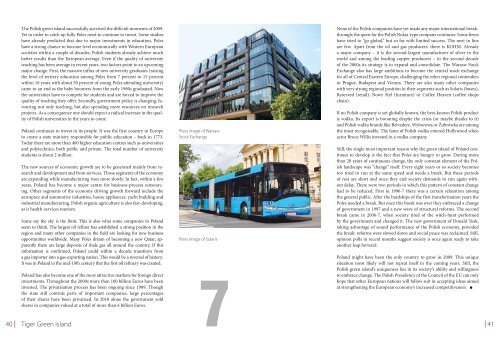„The Brighter Side of Europe” / Piotr Kaczyński
„The Brighter Side of Europe” / Piotr Kaczyński
„The Brighter Side of Europe” / Piotr Kaczyński
You also want an ePaper? Increase the reach of your titles
YUMPU automatically turns print PDFs into web optimized ePapers that Google loves.
The Polish green island successfully survived the difficult moments <strong>of</strong> 2009.<br />
Yet in order to catch up fully Poles need to continue to invest. Some studies<br />
have already predicted that due to major investments in education, Poles<br />
have a strong chance to become level economically with Western European<br />
societies within a couple <strong>of</strong> decades. Polish students already achieve much<br />
better results than the European average. Even if the quality <strong>of</strong> university<br />
teaching has been average in recent years, two factors point to an upcoming<br />
major change. First, the massive influx <strong>of</strong> new university graduates (raising<br />
the level <strong>of</strong> tertiary education among Poles from 7 percent to 15 percent<br />
within 10 years with about 50 percent <strong>of</strong> young Poles attending university)<br />
came to an end as the baby boomers from the early 1980s graduated. Now<br />
the universities have to compete for students and are forced to improve the<br />
quality <strong>of</strong> teaching they <strong>of</strong>fer. Secondly, government policy is changing, favouring<br />
not only teaching, but also spending more resources on research<br />
projects. As a consequence one should expect a radical increase in the quality<br />
<strong>of</strong> Polish universities in the years to come.<br />
Poland continues to invest in its people. It was the first country in Europe<br />
to create a state ministry responsible for public education – back in 1773.<br />
Today there are more than 400 higher education centres such as universities<br />
and polytechnics, both public and private. The total number <strong>of</strong> university<br />
students is about 2 million.<br />
The new sources <strong>of</strong> economic growth are to be generated mainly from research<br />
and development and from services. Those segments <strong>of</strong> the economy<br />
are expanding while manufacturing rises more slowly. In fact, within a few<br />
years, Poland has become a major centre for business-process outsourcing.<br />
Other segments <strong>of</strong> the economy driving growth forward include the<br />
aerospace and automotive industries, house appliances, yacht building and<br />
industrial manufacturing. Polish organic agriculture is also fast-developing,<br />
as is health-services tourism.<br />
Some say the sky is the limit. This is also what some companies in Poland<br />
seem to think. The largest oil refiner has established a strong position in the<br />
region and many other companies in the field are looking for new business<br />
opportunities worldwide. Many Poles dream <strong>of</strong> becoming a new Qatar; apparently<br />
there are large deposits <strong>of</strong> shale gas all around the country. If this<br />
information is confirmed, Poland could within a decade transform from<br />
a gas importer into a gas-exporting nation. This would be a reversal <strong>of</strong> history:<br />
It was in Poland in the mid-19th century that the first oil refinery was created.<br />
Poland has also become one <strong>of</strong> the most attractive markets for foreign direct<br />
investments. Throughout the 2000s more than 100 billion Euros have been<br />
invested. The privatisation process has been ongoing since 1989. Though<br />
the state still controls parts <strong>of</strong> important companies, large percentages<br />
<strong>of</strong> their shares have been privatised. In 2010 alone the government sold<br />
shares in companies valued at a total <strong>of</strong> more than 6 billion Euros.<br />
Press image <strong>of</strong> Warsaw<br />
Stock Exchange<br />
Press image <strong>of</strong> Solaris<br />
7<br />
None <strong>of</strong> the Polish companies have yet made any major international breakthrough;<br />
the quest for the Polish Nokia-type company continues. Some firms<br />
have tried to “go global,” but so far with limited success. The next in line<br />
are few. Apart from the oil and gas producers, there is KGHM. Already<br />
a major company – it is the second-largest manufacturer <strong>of</strong> silver in the<br />
world and among the leading copper producers – in the second decade<br />
<strong>of</strong> the 2000s its strategy is to expand and consolidate. The Warsaw Stock<br />
Exchange also has large ambitions to become the central stock exchange<br />
for all <strong>of</strong> Central Eastern Europe, challenging the other regional contenders<br />
in Prague, Budapest and Vienna. There are also many other companies<br />
with very strong regional position in their segments such as Solaris (buses),<br />
Reserved (retail), Nowy Styl (furniture) or C<strong>of</strong>fee Heaven (c<strong>of</strong>fee shops<br />
chain).<br />
If no Polish company is yet globally known, the best-known Polish product<br />
is vodka. Its export is booming despite the crisis (or maybe thanks to it)<br />
and Polish vodka brands like Belvedere, Wyborowa or Żubrówka are among<br />
the most recognisable. The fame <strong>of</strong> Polish vodka entered Hollywood when<br />
actor Bruce Willis invested in a vodka company.<br />
Still, the single most important reason why the green island <strong>of</strong> Poland continues<br />
to develop is the fact that Poles are hungry to grow. During more<br />
than 20 years <strong>of</strong> continuous change, the only constant element <strong>of</strong> the Polish<br />
landscape was “change” itself. Every eight years or so society becomes<br />
too tired to run at the same speed and needs a break. But these periods<br />
<strong>of</strong> rest are short and once they end society demands to run again without<br />
delay. There were two periods in which this pattern <strong>of</strong> constant change<br />
had to be reduced. First in 1996-7 there was a certain relaxation among<br />
the general public. After the hardships <strong>of</strong> the first transformation years the<br />
Poles needed a break. But once this break was over they embraced a change<br />
<strong>of</strong> government in 1997 and a new wave <strong>of</strong> structural reforms. The second<br />
break came in 2006-7, when society tired <strong>of</strong> the witch-hunt performed<br />
by the government and changed it. The new government <strong>of</strong> Donald Tusk,<br />
taking advantage <strong>of</strong> sound performance <strong>of</strong> the Polish economy, provided<br />
the break: reforms were slowed down and social peace was reclaimed. Still,<br />
opinion polls in recent months suggest society is once again ready to take<br />
another leap forward.<br />
Poland might have been the only country to grow in 2009. This unique<br />
situation most likely will not repeat itself in the coming years. Still, the<br />
Polish green island’s uniqueness lies in its society’s ability and willingness<br />
to embrace change. The Polish Presidency <strong>of</strong> the Council <strong>of</strong> the EU can only<br />
hope that other European nations will follow suit in accepting ideas aimed<br />
at strengthening the European economy’s increased competitiveness.<br />
40 | Tiger Green Island<br />
| 41



